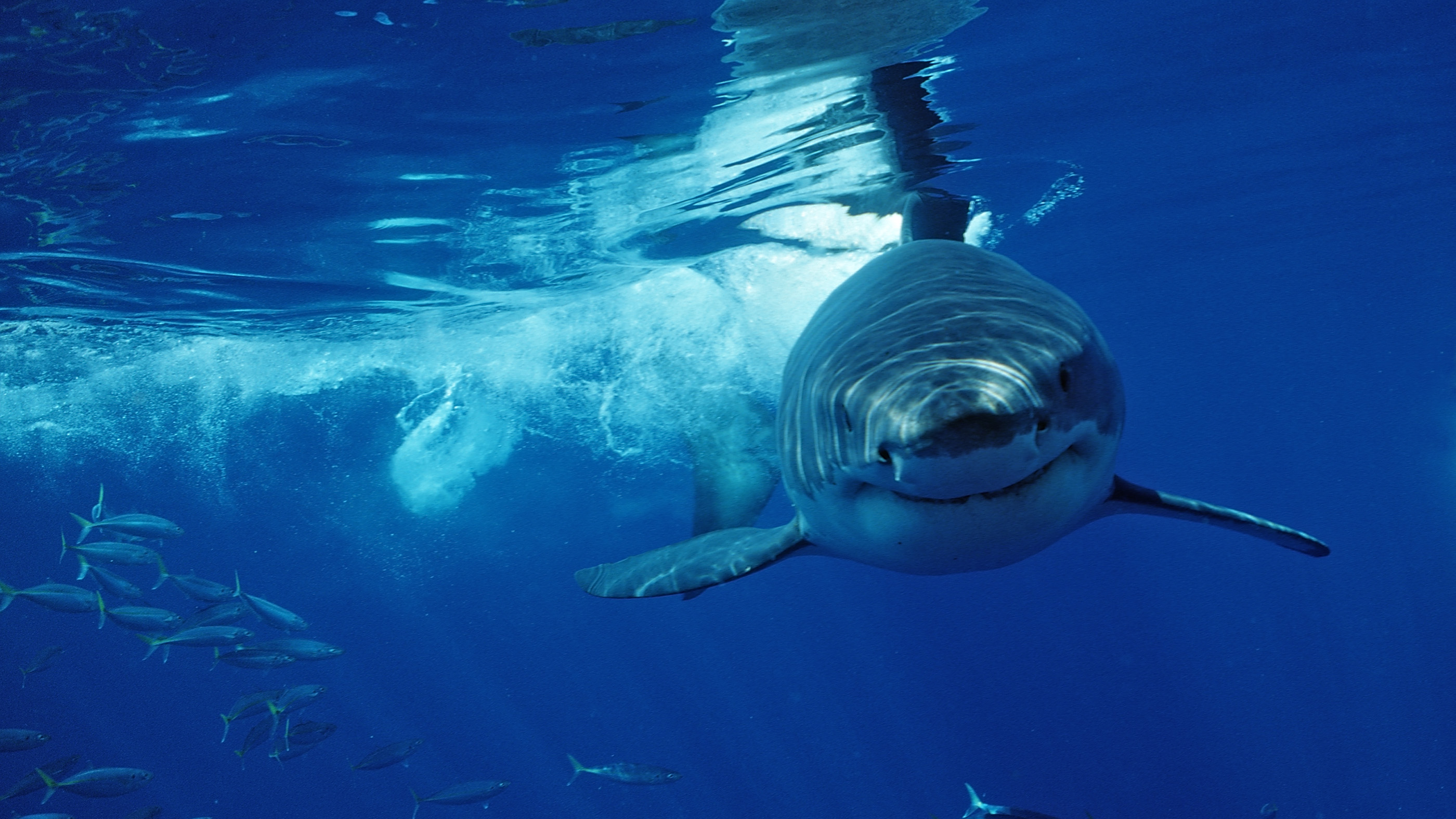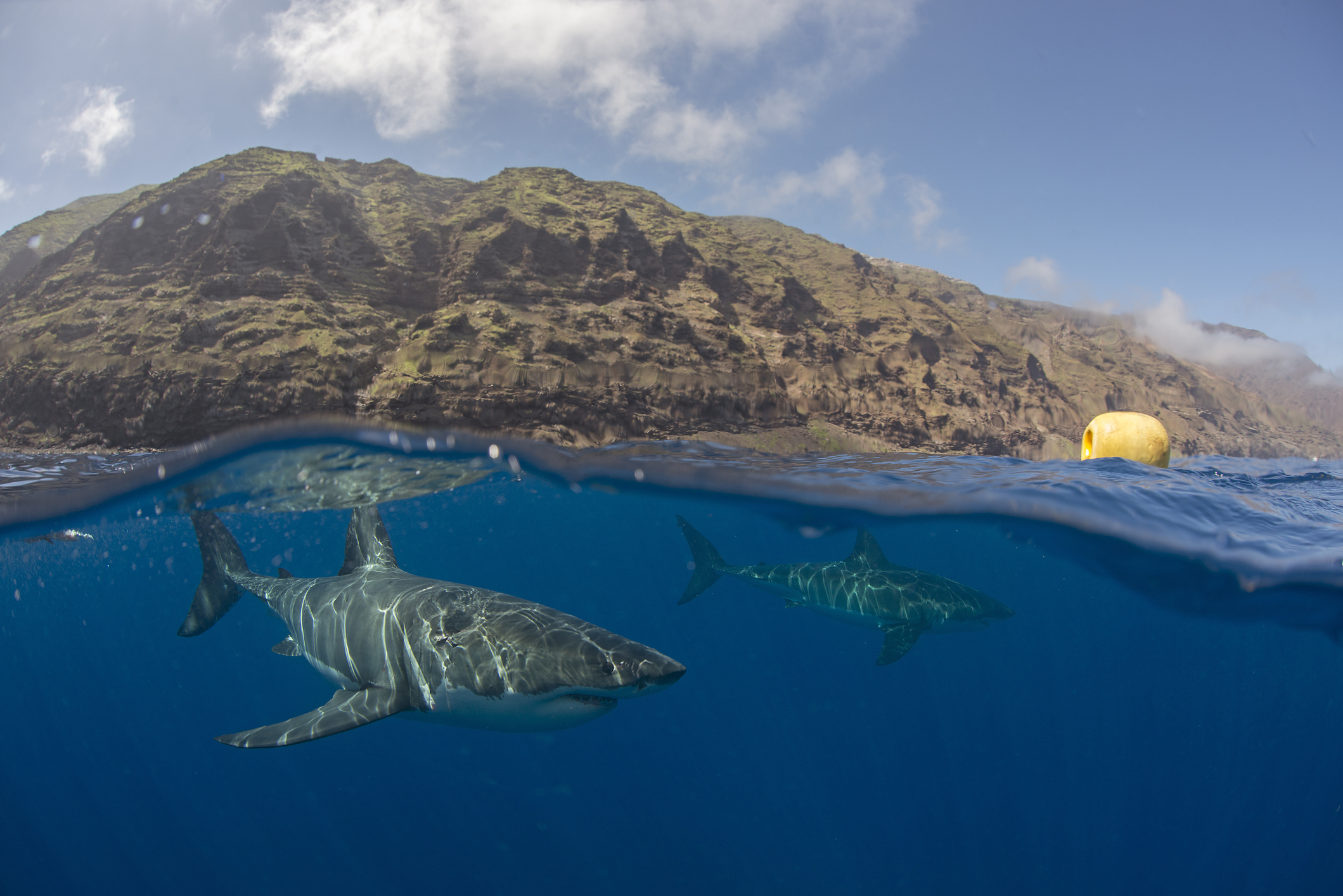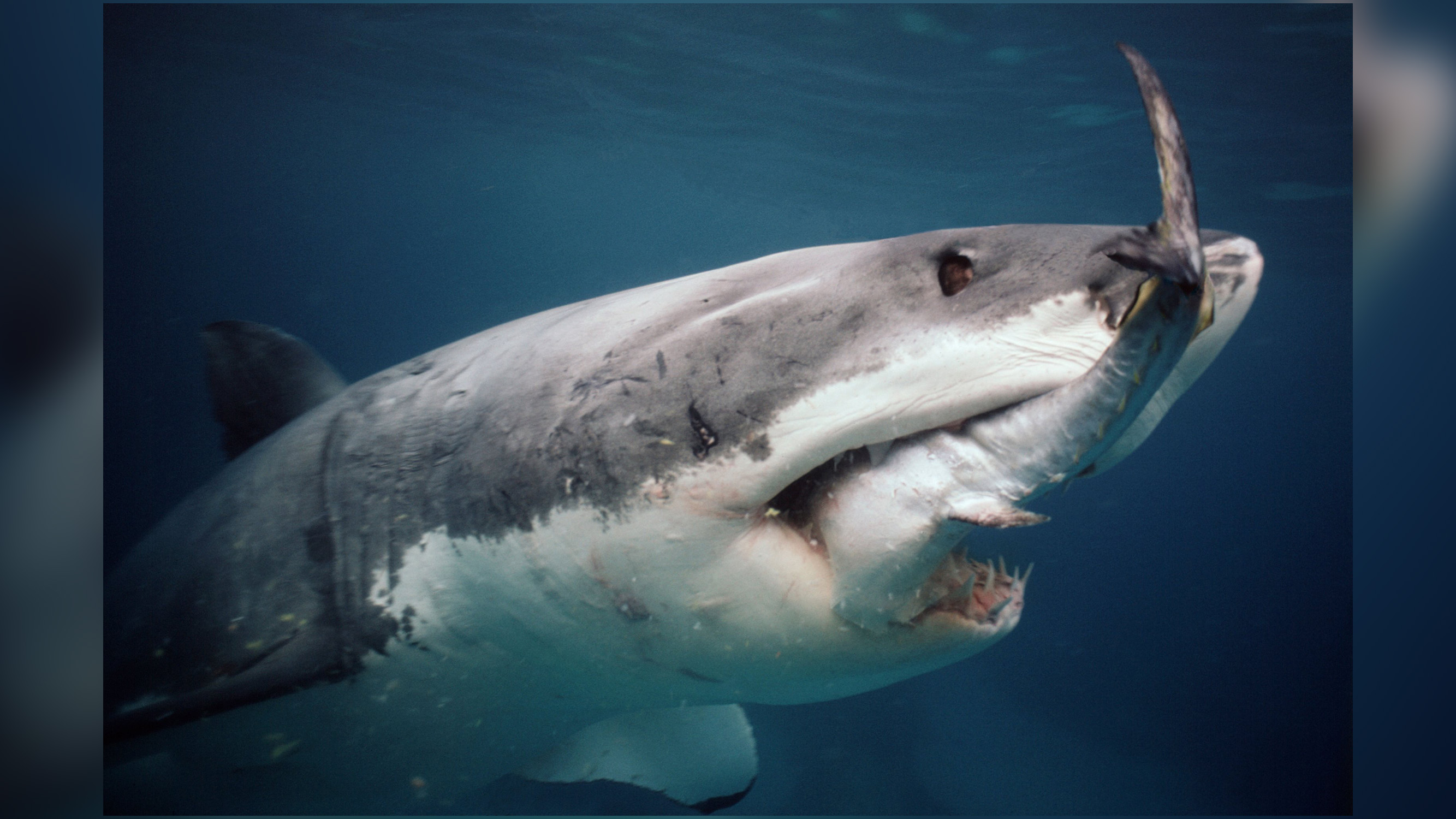Great white sharks: The world's largest predatory fish
Great white sharks are anything but mindless killers.

Great white sharks, (Carcharodon carcharias), also known as white sharks, are the largest predatory fish in the world. They belong to a partially "warm-blooded" family of sharks called Lamnidae, or mackerel sharks, that are able to maintain an internal body temperature that's warmer than their external environment — unlike other "cold-blooded" sharks, which can't, according to the Florida Museum of Natural History.
Great white sharks are the only living members of the genus Carcharodon — inspired by the Greek words "karcharos," which means sharpen, and "odous," which means teeth. This name is well-chosen, as great white sharks have rows of up to 300 serrated, triangular teeth. These sharks have bullet-shaped bodies, gray skin and white bellies.
Despite being one of the best-known shark species thanks to movies such as "Jaws" (1975), great white sharks live a secretive lifestyle, and scientists still have much to learn about these iconic predators.
Size
How big are great white sharks?
Great white shark size varies, but females can grow to be larger than males. Female great white sharks reach an average length of 15 to 16 feet (4.6 to 4.9 meters), while males usually reach 11 to 13 feet (3.4 to 4 m), according to the Smithsonian National Museum of Natural History in Washington D.C. The largest great white sharks can grow to 20 feet long (6.1 m), and there are unconfirmed reports of great whites growing to 23 feet long (7 m), according to the Florida Museum of Natural History. Adults weigh between 4,000 and 7,000 pounds (1,800 and 3,000 kilograms), according to the World Wildlife Fund (WWF).
Great whites are not the biggest sharks in the world. That title goes to whale sharks (Rhincodon typus), which are filter-feeders and usually grow up to 33 feet (10 m) long and weigh around 42,000 pounds (19,000 kg). The biggest shark species ever was the now-extinct megalodon (Carcharocles megalodon), which may have grown up to 60 feet long (18 m) or more, although scientists are still debating its exact size.
Related: Scientists discover great white shark 'queen of the ocean'
Habitat
Where do great white sharks live?
Great white sharks have a large geographic range; they live in most temperate and tropical oceans around the world and have resident populations off the coasts of the U.S., Australia, South Africa and other countries. They are most often sighted in cooler, temperate waters and swim at the surface as well as down to more than 3,900 feet (1,200 m) below the surface, according to the International Union for Conservation of Nature (IUCN).
Kingdom: Animalia
Phylum: Chordata
Class: Chondrichthyes
Order: Lamniformes
Family: Lamnidae
Genus & species: Carcharodon carcharias
Source: ITIS
Great white sharks are migratory and undertake long-distance journeys across the open ocean, possibly for food and breeding. A 2002 study published in the journal Nature found that one great white shark swam 2,360 miles (3,800 kilometers) from the coast of central California to the Hawaiian island of Kahoolawe. In 2005, researchers tracked a great white shark swimming almost 6,900 miles (11,100 km) from the coast of South Africa to Australia, before later heading back again, Mongabay reported. To have enough energy for such long journeys, great white sharks store energy in their oil-rich livers, according to the Monterey Bay Aquarium.
Related: Great white shark population off California's coast is growing
Get the world’s most fascinating discoveries delivered straight to your inbox.
Behavior
Are great white sharks dangerous?
Shark attacks are extremely rare. In 2022, just 41 shark bites were reported in the U.S., and just one was fatal. In fact, the majestic beasts actually have almost no interest in eating humans, a 2023 study found.
In fact, when researchers flew drones over the beaches of Southern California, they found juvenile sharks tended to congregate in areas heavily used by people. Yet they harmlessly swimming alongside surfers, paddleboarders and swimmers and only one unofficial shark attack was reported from these locations.
“I think what we've finally done is put a nail in the coffin for the old myth that if you're in the water with a white shark, it's going to attack you,” study co-author Chris Lowe, a marine biologist at California State University, Long Beach, previously told Live Science.
When sharks do bite humans, it's likely to be a mistake. A 2021 study published in the Journal of the Royal Society Interface found that to a juvenile great white shark, the shape and motion of humans swimming or paddling on surfboards looks the same as seals — one of their main sources of food. This suggests attacks could be a case of mistaken identity, at least for juveniles.
"White sharks are often portrayed as 'mindless killers' and 'fond of human flesh,' however, this does not seem to be the case, we just look like their food," Laura Ryan, lead author of the 2021 study and a postdoctoral researcher at Macquarie University in Australia, previously told Live Science.
When someone has been bitten by a shark, experts often find it difficult to establish which shark species was involved. Sharks don't hang around for identification, and victims can struggle to make an accurate observation of the shark in the heat of the moment. Many shark species also create similar-looking wounds. Shark attack data is therefore skewed towards easily identified species such as great white sharks, according to the Florida Museum of Natural History's International Shark Attack Files (ISAF). The ISAF data show there have been 354 unprovoked great white shark attacks, including 57 fatal encounters, recorded since 1580 — more than any other shark species.
Related: Man survives attack by great white shark off California beach
Diet
What do great white sharks eat?
Great white sharks are apex predators that eat a variety of prey, including fish, seals, sea turtles and seabirds. They typically eat smaller prey such as squids and stingrays when they are younger and then shift to eating marine mammals such as seals, sea lions and dolphins once they mature, according to the Australian Museum in Sydney.
By hunting prey, great white sharks and other sharks play an important role in the ocean. They keep prey populations healthy by catching weak and sick individuals and prevent those populations from growing too large for a habitat's resources to support, Live Science previously reported. Great white sharks can also be prey themselves, but their risk of predation drops as they get older and larger. The only things that eat adult great white sharks are larger adult great whites and killer whales (Orcinus orca), which may hunt great whites for their energy-rich livers.
Related: Video captures great white shark's gruesome attack on a seal near Cape Cod
Mating
How do great white sharks mate?
Scientists still have plenty to learn about great white sharks, and much of their mating behavior remains a mystery. Researchers have interpreted some bite marks observed on mature female sharks as mating scars, which are caused by males grabbing females during mating, according to the Florida Museum of Natural History.
Scientists have studied shark specimens, such as accidentally caught pregnant females, and know that great white sharks don't lay eggs. Fertilized eggs hatch inside a female's body and develop there until the female gives birth. A 2016 study published in the journal Biology Open found that embryos probably feed on uterine fluid and undeveloped eggs between when they hatch inside the mother and when they are born. While in their mother's womb, young great whites also swallow their own teeth, according to the Florida Museum of Natural History. They may do this to reutilize calcium and other minerals.
Scientists assume that great white sharks give birth in warm temperate and tropical waters, but they have not identified specific shark nurseries. Gestation is thought to take about a year, after which a female gives birth to between two and 10 offspring called pups, according to the University of Michigan's Animal Diversity Web. Pups are more than 3 feet (1 m) long when they are born and are able to take care of themselves.
A 2014 study published in the journal PLOS One estimated great white sharks' lifespan based on radiocarbon levels in their vertebrae tissue. The researchers suggested that the oldest female shark in the study was 40 years old and the oldest male was 73 years old. This suggests that males may live longer than females, but further research is needed to corroborate these findings.
Related: Secret great white shark social club discovered off Mexican coast
Conservation status
Are great white sharks endangered?
Great white sharks are vulnerable to extinction and their population is decreasing, according to a 2018 assessment by the IUCN. This means that while these sharks are not technically endangered yet, they are at risk of becoming endangered unless their situation improves. The IUCN didn't have enough data to estimate great white sharks' total population size.
Great white sharks are threatened globally as bycatch — animals caught by fishers that are not the intended target. Great white sharks are also deliberately killed by humans as part of beach-protection programs in Australia and South Africa, although sharks are sometimes captured and released alive.
Additional resources
To learn more about why great white sharks are scarcely seen in captivity and how the Monterey Bay Aquarium was able to briefly display them, watch this short YouTube video by Vox. For more information about shark attacks and how to avoid them, check out the International Shark Attack Files website. For a general guide to the world's sharks, check out "Sharks of the World: A Complete Guide" (Princeton University Press, 2021), available to buy at Amazon.
Bibliography
Boustany et al. "Expanded niche for white sharks," Nature, Volume 415, Jan. 3, 2002. https://www.nature.com/articles/415035b
Chewning, D. and Hall, M. Animal Diversity Web, "Carcharodon carcharias," 2009. https://animaldiversity.org/accounts/Carcharodon_carcharias/
Florida Museum of Natural History, "Shark Biology," Aug. 9, 2021. https://www.floridamuseum.ufl.edu/discover-fish/sharks/shark-biology/
Hamady et al. "Vertebral bomb radiocarbon suggests extreme longevity in white sharks," PLOS One, Volume 9, Jan. 8, 2014. https://journals.plos.org/plosone/article?id=10.1371/journal.pone.0084006
International Shark Attack Files, Florida Museum of Natural History, "Species Implicated in Attacks," updated Jan. 25, 2022. https://www.floridamuseum.ufl.edu/shark-attacks/factors/species-implicated/
Martins, C. and Knickle, C. Florida Museum of Natural History, "Carcharodon carcharias," updated Oct. 18, 2018. https://www.floridamuseum.ufl.edu/discover-fish/species-profiles/carcharodon-carcharias/
McGrouther, M., Australian Museum, "White Shark, Carcharodon carcharias (Linnaeus, 1758)," March 5, 2020. https://australian.museum/learn/animals/fishes/white-shark-carcharodon-carcharias-linnaeus-1758/
Monterey Bay Aquarium, "White shark." https://www.montereybayaquarium.org/animals/animals-a-to-z/white-shark
National Geographic, "Great white sharks." https://www.nationalgeographic.com/animals/fish/facts/great-white-shark
Pester, P., Live Science, "Great white sharks can't see a difference between humans and prey," Oct. 27, 2021. https://www.livescience.com/great-white-shark-mistaken-identity
Rigby et al. The IUCN Red List of Threatened Species, "Carcharodon carcharias," 2019. https://www.iucnredlist.org/species/3855/2878674
Ryan et al. "A shark's eye view: testing the 'mistaken identity theory' behind shark bites on humans," Journal of the Royal Society Interface, Volume 18, Oct. 27, 2021. https://royalsocietypublishing.org/rsif/doi/10.1098/rsif.2021.0533
Sato et al. "How great white sharks nourish their embryos to a large size: evidence of lipid histotrophy in lamnoid shark reproduction," Biology Open, Volume 5, Sep. 15, 2016. https://journals.biologists.com/bio/article/5/9/1211/1210/How-great-white-sharks-nourish-their-embryos-to-a
Smithsonian National Museum of Natural History, "How Big are Great White Sharks?" https://ocean.si.edu/ocean-life/sharks-rays/how-big-are-great-white-sharks
Weisberger, M., Live Science, "What If There Were No Sharks?" Sep. 9, 2019. https://www.livescience.com/what-if-no-sharks.html

Patrick Pester is the trending news writer at Live Science. His work has appeared on other science websites, such as BBC Science Focus and Scientific American. Patrick retrained as a journalist after spending his early career working in zoos and wildlife conservation. He was awarded the Master's Excellence Scholarship to study at Cardiff University where he completed a master's degree in international journalism. He also has a second master's degree in biodiversity, evolution and conservation in action from Middlesex University London. When he isn't writing news, Patrick investigates the sale of human remains.




